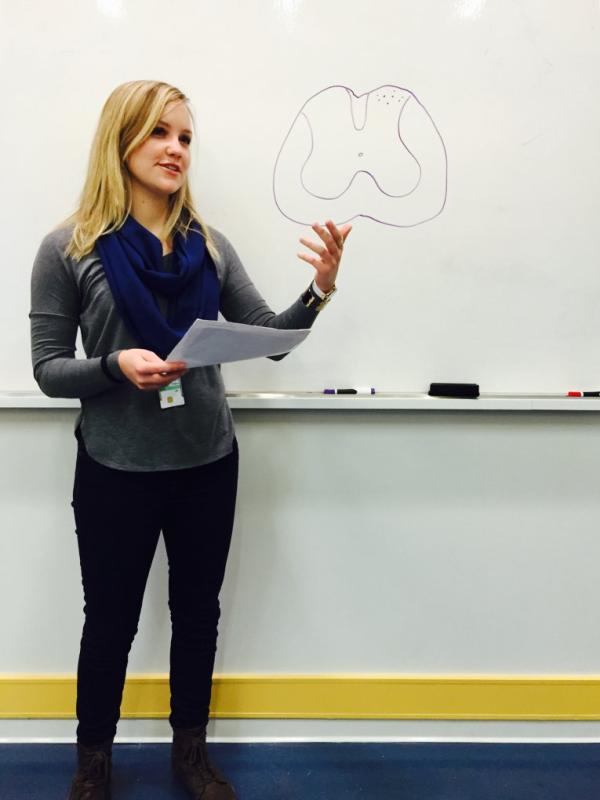5 Tips for Journal Club First-Timers
Research communities often uphold the ideal of scientific collaboration. But what does “collaboration” really mean? The picture that comes to mind can be people sitting, talking, and exchanging ideas that push toward the goal of creating better health. How can this exchange practically happen? One way is through a journal club. Recently, I had the privilege of presenting a journal article to my lab group’s journal club in the PAIN (Pain And Integrative Neuroscience) lab for Dr. Catherine Bushnell. One goal of our lab is to look at the relationship and differences between itch and pain.

Me explaining part of the spinal neuron pathway in itch
So, what is the purpose of a journal club?
A journal club is a regular gathering of scientists to discuss a scientific paper found in a research journal. One or two members of the club present a summary of the chosen paper that the whole group has read. Then, the discussion begins. Attendees ask clarifying questions, inquire about different aspects of the experimental design, critique the methods, and bring a healthy amount of skepticism (or praise) to the results.
For my first journal club at the NIH, we considered a paper that looks at how itch is mediated in the spinal cord from the skin up to the brain. The authors show that mice lacking a gene for a specific type of spinal neuron constantly scratch specific areas of their bodies corresponding to the missing spinal interneuron. When these mice receive a stem cell implant, a normal reaction to itch is restored. This paper generated much discussion about neuronal development, ethical considerations, and how the results relate to our research within the National Center for Complementary and Integrative Health (NCCIH).
The ideas found and discussed at the journal club can help expand and balance each scientist’s scope of what is happening in the world of research while informing experimental plans and research directions. Here are five things I learned from my experience leading a journal club that can help you prepare to get the most out of your discussions:
1. Know the background material.
Prepare beforehand for your journal club presentation by knowing the research that has preceded and is related to the paper you will be presenting. This will make your discussion more informed and effective. Of course, it is likely impossible to know everything that would relate to your journal club presentation, but even a little bit of background information is helpful.
2. Make your presentation concise.
Every paper has many details about methods, results, discussion, future directions, etc. It is very helpful to give your audience the general flow of the entire paper and research before adding in all the details.
3. Simplify unfamiliar concepts.
Journal clubs often have members of varying backgrounds. Hence, not all concepts will be familiar to everyone in the group. It can be helpful to give a short summary of techniques and results. Detailed explanations can be provided later on, because the primary focus of presenting the paper should be giving an overview of the research.
4. Ask yourself questions about the paper before you present.
As the presenter, you may be the semi-“expert” on the paper, but as you get to know the research, you may discover some questions you have about the methods. Share with the group the questions you came across yourself and any answers you may have found to address them.
5. Ask specific questions to the members of the journal club.
When entering into discussion time, ask the group for their thoughts on specific topics found in the paper to create a starting point for conversation about the paper. Questions can be about methods, results, general ideas, and much more!
Journal clubs are great forums for the exchange of thoughts and ideas. Clubs held at the NIH are just one way through which necessary scientific discussion and collaboration can take place. Be sure to look into journal clubs happening near you!
If you’re at the NIH, the Office of Intramural Training and Education (OITE) hosts Summer Journal Clubs that are ideal for trainees just getting their feet wet. And for our colleagues around the world, the NIH National Library of Medicine (NLM) provides an online platform to discuss journal articles in our connected world via the PubMed Commons Journal Clubs.
Related Blog Posts
This page was last updated on Wednesday, July 5, 2023
